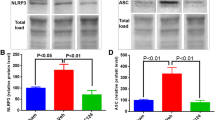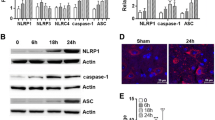Abstract
Increasing evidence has revealed that neuroinflammation plays a pivotal role in axonal injures. Nucleotide oligomerization domain (NOD)-like receptor protein (NLRP3) inflammasome is reported to be widely involved with the pathology of central nervous system disorders. But the role of NLRP3 in diffuse axonal injury (DAI) are rarely reported. The purpose of this study was to investigate the expression of NLRP3 after diffuse axonal injury and the role of NLRP3 in axonal injures. The lateral head rotation device was used to establish DAI model of rats. Immunohistochemical staining for β-amyloid precursor protein and Bielschowsky silver staining were used to assess axonal injures and axonal loss. Terminal Deoxynucleotidyl Transferase-Mediated Digoxigenin-dUTP-Biotin Nick-End Labelling Assay was used to detect cell apoptosis. Brain water content was used to assess cerebral edema and the modified Neurologic Severity Score was used to assess the neurological deficits. Components of NLRP3 inflammasome, such as NLRP3, apoptosis-associated speck-like (ASC) adapter protein and caspase-1, and pro-inflammatory cytokines, for example IL-18 and IL-1β, were over-expressed in early stages of DAI. MCC950, a selective small-molecule inhibitor of NLRP3 inflammasome, inhibited the over-expression of NLRP3 inflammasome and pro-inflammatory cytokines after DAI. MCC950 alleviated axonal injures and cell apoptosis. MCC950 also decreased brain water content and alleviated neurologic deficits 1 day and 3 days after DAI but not 7 days after DAI. These results suggest that MCC950 treatment in the early stages of DAI has a time limiting effect in preventing from axonal injuries and neurological deficits, and that NLRP3 inflammasome plays an important role in axonal injures and may be a potential candidate for axonal injures following DAI.







Similar content being viewed by others
References
Frati A, Cerretani D, Fiaschi AI, Frati P, Gatto V, La Russa R, Pesce A, Pinchi E, Santurro A, Fraschetti F, Fineschi V (2017) Diffuse axonal injury and oxidative stress: a comprehensive review. Int J Mol Sci. https://doi.org/10.3390/ijms18122600
Ma J, Zhang K, Wang Z, Chen G (2016) Progress of research on diffuse axonal injury after traumatic brain injury. Neural Plast 2016:9746313. https://doi.org/10.1155/2016/9746313
Peeters W, Majdan M, Brazinova A, Nieboer D, Maas AIR (2017) Changing epidemiological patterns in traumatic brain injury: a longitudinal hospital-based study in Belgium. Neuroepidemiology 48:63–70. https://doi.org/10.1159/000471877
Rudolfson N, Dewan MC, Park KB, Shrime MG, Meara JG, Alkire BC (2018) The economic consequences of neurosurgical disease in low- and middle-income countries. J Neurosurg. https://doi.org/10.3171/2017.12.jns17281
Johnson VE, Stewart W, Smith DH (2013) Axonal pathology in traumatic brain injury. Exp Neurol 246:35–43. https://doi.org/10.1016/j.expneurol.2012.01.013
Maas AI, Stocchetti N, Bullock R (2008) Moderate and severe traumatic brain injury in adults. Lancet Neurol 7:728–741. https://doi.org/10.1016/s1474-4422(08)70164-9
Lin C, Chao H, Li Z, Xu X, Liu Y, Hou L, Liu N, Ji J (2016) Melatonin attenuates traumatic brain injury-induced inflammation: a possible role for mitophagy. J Pineal Res 61:177–186. https://doi.org/10.1111/jpi.12337
Zhao Y, Zhao Y, Zhang M, Zhao J, Ma X, Huang T, Pang H, Li J, Song J (2016) Inhibition of TLR4 signalling-induced inflammation attenuates secondary injury after diffuse axonal injury in rats. Mediat Inflamm 2016:4706915. https://doi.org/10.1155/2016/4706915
Wang G, Shi Y, Jiang X, Leak RK, Hu X, Wu Y, Pu H, Li WW, Tang B, Wang Y, Gao Y, Zheng P, Bennett MV, Chen J (2015) HDAC inhibition prevents white matter injury by modulating microglia/macrophage polarization through the GSK3beta/PTEN/Akt axis. Proc Natl Acad Sci USA 112:2853–2858. https://doi.org/10.1073/pnas.1501441112
Ismael S, Nasoohi S, Ishrat T (2018) MCC950, the selective inhibitor of nucleotide oligomerization domain-like receptor protein-3 inflammasome, protects mice against traumatic brain injury. J Neurotrauma 35:1294–1303. https://doi.org/10.1089/neu.2017.5344
Mortezaee K, Khanlarkhani N, Beyer C, Zendedel A (2018) Inflammasome: Its role in traumatic brain and spinal cord injury. J Cell Physiol 233:5160–5169. https://doi.org/10.1002/jcp.26287
Fann DY, Lim YA, Cheng YL, Lok KZ, Chunduri P, Baik SH, Drummond GR, Dheen ST, Sobey CG, Jo DG, Chen CL, Arumugam TV (2018) Evidence that NF-kappaB and MAPK signaling promotes NLRP inflammasome activation in neurons following ischemic stroke. Mol Neurobiol 55:1082–1096. https://doi.org/10.1007/s12035-017-0394-9
Zhou K, Enkhjargal B, Xie Z, Sun C, Wu L, Malaguit J, Chen S, Tang J, Zhang J, Zhang JH (2018) Dihydrolipoic acid inhibits lysosomal rupture and NLRP3 through lysosome-associated membrane protein-1/calcium/calmodulin-dependent protein kinase II/TAK1 pathways after subarachnoid hemorrhage in rat. Stroke 49:175–183. https://doi.org/10.1161/strokeaha.117.018593
Li Y, Song J, Liu X, Zhang M, An J, Sun P, Li D, Jin T, Wang J (2013) High expression of STIM1 in the early stages of diffuse axonal injury. Brain Res 1495:95–102. https://doi.org/10.1016/j.brainres.2012.12.005
Zhao Y, Zhao J, Zhang M, Zhao Y, Li J, Ma X, Huang T, Pang H, Wang B, Song J (2017) Involvement of toll like receptor 2 signaling in secondary injury during experimental diffuse axonal injury in rats. Mediat Inflamm 2017:1570917. https://doi.org/10.1155/2017/1570917
Luo Y, Lu J, Ruan W, Guo X, Chen S (2019) MCC950 attenuated early brain injury by suppressing NLRP3 inflammasome after experimental SAH in rats. Brain Res Bull 146:320–326. https://doi.org/10.1016/j.brainresbull.2019.01.027
Zhao J, Wang B, Huang T, Guo X, Yang Z, Song J, Zhang M (2019) Glial response in early stages of traumatic brain injury. Neurosci Lett 708:134335. https://doi.org/10.1016/j.neulet.2019.134335
Huang T, Zhao J, Guo D, Pang H, Zhao Y, Song J (2018) Curcumin mitigates axonal injury and neuronal cell apoptosis through the PERK/Nrf2 signaling pathway following diffuse axonal injury. NeuroReport 29:661–677. https://doi.org/10.1097/wnr.0000000000001015
Xiong T, Qu Y, Wang H, Chen H, Zhu J, Zhao F, Zou R, Zhang L, Mu D (2018) GSK-3beta/mTORC1 couples synaptogenesis and axonal repair to reduce hypoxia ischemia-mediated brain injury in neonatal rats. J Neuropathol Exp Neurol 77:383–394. https://doi.org/10.1093/jnen/nly015
Chen J, Zacharek A, Cui X, Shehadah A, Jiang H, Roberts C, Lu M, Chopp M (2010) Treatment of stroke with a synthetic liver X receptor agonist, TO901317, promotes synaptic plasticity and axonal regeneration in mice. J Cereb Blood Flow Metab 30:102–109. https://doi.org/10.1038/jcbfm.2009.187
He XF, Zeng YX, Li G, Feng YK, Wu C, Liang FY, Zhang Y, Lan Y, Xu GQ, Pei Z (2019) Extracellular ASC exacerbated the recurrent ischemic stroke in an NLRP3-dependent manner. J Cereb Blood Flow Metab. https://doi.org/10.1177/0271678x19856226
Zhou K, Shi L, Wang Z, Zhou J, Manaenko A, Reis C, Chen S, Zhang J (2017) RIP1-RIP3-DRP1 pathway regulates NLRP3 inflammasome activation following subarachnoid hemorrhage. Exp Neurol 295:116–124. https://doi.org/10.1016/j.expneurol.2017.06.003
Heneka MT, Kummer MP, Stutz A, Delekate A, Schwartz S, Vieira-Saecker A, Griep A, Axt D, Remus A, Tzeng TC, Gelpi E, Halle A, Korte M, Latz E, Golenbock DT (2013) NLRP3 is activated in Alzheimer's disease and contributes to pathology in APP/PS1 mice. Nature 493:674–678. https://doi.org/10.1038/nature11729
Sarkar S, Malovic E, Harishchandra DS, Ghaisas S, Panicker N, Charli A, Palanisamy BN, Rokad D, Jin H, Anantharam V, Kanthasamy A, Kanthasamy AG (2017) Mitochondrial impairment in microglia amplifies NLRP3 inflammasome proinflammatory signaling in cell culture and animal models of Parkinson's disease. NPJ Parkinson's Dis 3:30. https://doi.org/10.1038/s41531-017-0032-2
Croisier E, Moran LB, Dexter DT, Pearce RK, Graeber MB (2005) Microglial inflammation in the parkinsonian substantia nigra: relationship to alpha-synuclein deposition. J Neuroinflamm 2:14. https://doi.org/10.1186/1742-2094-2-14
Xu X, Yin D, Ren H, Gao W, Li F, Sun D, Wu Y, Zhou S, Lyu L, Yang M, Xiong J, Han L, Jiang R, Zhang J (2018) Selective NLRP3 inflammasome inhibitor reduces neuroinflammation and improves long-term neurological outcomes in a murine model of traumatic brain injury. Neurobiol Dis 117:15–27. https://doi.org/10.1016/j.nbd.2018.05.016
Coll RC, Robertson AA, Chae JJ, Higgins SC, Munoz-Planillo R, Inserra MC, Vetter I, Dungan LS, Monks BG, Stutz A, Croker DE, Butler MS, Haneklaus M, Sutton CE, Nunez G, Latz E, Kastner DL, Mills KH, Masters SL, Schroder K, Cooper MA, O'Neill LA (2015) A small-molecule inhibitor of the NLRP3 inflammasome for the treatment of inflammatory diseases. Nat Med 21:248–255. https://doi.org/10.1038/nm.3806
Dempsey C, Rubio Araiz A, Bryson KJ, Finucane O, Larkin C, Mills EL, Robertson AAB, Cooper MA, O'Neill LAJ, Lynch MA (2017) Inhibiting the NLRP3 inflammasome with MCC950 promotes non-phlogistic clearance of amyloid-beta and cognitive function in APP/PS1 mice. Brain Behav Immun 61:306–316. https://doi.org/10.1016/j.bbi.2016.12.014
Wang S, Yuan YH, Chen NH, Wang HB (2019) The mechanisms of NLRP3 inflammasome/pyroptosis activation and their role in Parkinson's disease. Int Immunopharmacol 67:458–464. https://doi.org/10.1016/j.intimp.2018.12.019
Vanaja SK, Rathinam VA, Fitzgerald KA (2015) Mechanisms of inflammasome activation: recent advances and novel insights. Trends Cell Biol 25:308–315. https://doi.org/10.1016/j.tcb.2014.12.009
Bergsbaken T, Fink SL, Cookson BT (2009) Pyroptosis: host cell death and inflammation. Nat Rev Microbiol 7:99–109. https://doi.org/10.1038/nrmicro2070
Man SM, Kanneganti TD (2016) Converging roles of caspases in inflammasome activation, cell death and innate immunity. Nat Rev Immunol 16:7–21. https://doi.org/10.1038/nri.2015.7
Wang G, Zhang J, Hu X, Zhang L, Mao L, Jiang X, Liou AK, Leak RK, Gao Y, Chen J (2013) Microglia/macrophage polarization dynamics in white matter after traumatic brain injury. J Cereb Blood Flow Metab 33:1864–1874. https://doi.org/10.1038/jcbfm.2013.146
Acknowledgements
We gratefully acknowledge the National Natural Science Foundation of China (No. 81471179) in funding this research. We also acknowledge Translational Medicine of the First Affiliated Hospital of Xi’an Jiaotong University for support of laboratory instruments.
Author information
Authors and Affiliations
Contributions
JZ and JS designed this research. JZ and JS wrote the article. JZ and BW performed the experiment. XG, DG and ZY did behavior tests and analyzed the experiments. TH and MZ did statistical analysis.
Corresponding author
Ethics declarations
Conflict of interest
All authors declare no conflict of interests.
Additional information
Publisher's Note
Springer Nature remains neutral with regard to jurisdictional claims in published maps and institutional affiliations.
Rights and permissions
About this article
Cite this article
Zhao, J., Guo, X., Wang, B. et al. MCC950 Inhibits NLRP3 Inflammasome and Alleviates Axonal Injures in Early Stages of Diffuse Axonal Injury in Rats. Neurochem Res 45, 2020–2031 (2020). https://doi.org/10.1007/s11064-020-03063-6
Received:
Revised:
Accepted:
Published:
Issue Date:
DOI: https://doi.org/10.1007/s11064-020-03063-6




